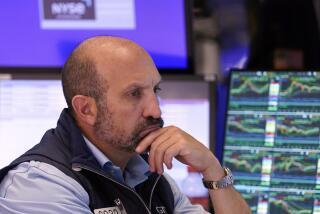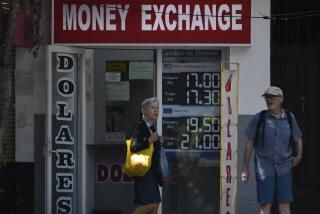COPING WITH THE WEAK DOLLAR : Foreigners Fed Up With the U.S. Dollar
The real reason the dollar has been sinking like a stone is not emotional questions about Clinton Administration foreign policy or pending trade wars. Itâs simply that foreign governments and private investors have been dumping U.S. stocks, bonds and Treasury securities for most of this year--$38 billion in the first quarter, possibly as much again in April, May and June, for which statistics are not yet available.
The foreigners have been selling stocks and bonds for the same reason American investors have: They saw rising interest rates hurting the U.S. economy, says Edward M. Bernstein, one of Americaâs true currency experts, a veteran of the 1944 conference at Bretton Woods, N.H., that set up the post-World War II international monetary system.
But that conflicts with conventional thinking, which says the Federal Reserve must raise interest rates to forestall inflation and defend the dollar. In fact, all sorts of experts are shouting at the Fed to raise rates again next Tuesday.
But that could be disastrous, says Bernstein, who is now 89 but comes in every morning at 7:45 to an office at Washingtonâs Brookings Institution. âIf the Fed raises interest rates again, it would lead to more selling of U.S. securities and further declines in the dollar,â he says.
The conventional thinking is flawed, he is saying, and could well end up sending the economy into recession.
The markets seem to agree. On Tuesday, fears of new Fed action weakened the dollar along with stocks and bonds.
But the falling dollar evidently does not reflect doubts about the underlying value of U.S. businesses. On the contrary, the dollar is seen as creating bargains for overseas companies wanting to acquire U.S. assets.
Gerber Products, the baby foods company, and drug company Syntex Ltd. are being acquired by two Swiss companies, Sandoz and Hoffman La Roche. The fact that the dollar has fallen 10% against the Swiss franc in the last year makes such deals attractive. Wall Street pros expect acquisitions by European firms to boom.
âThere will be some action from Japan, but most of it will come from Europe,â says one investment manager.
Itâs logical that the same cheap dollar that makes U.S exports attractive should make whole companies seem like bargains. But itâs sometimes hard to gauge value in modern currency markets.
This yearâs decline in the dollar, Bernstein explains, has been the result of portfolio transactions--foreign central banks reduced purchases of U.S. Treasury securities by $21.4 billion in the first quarter and private investors sold another $17.7 billion worth of U.S. stocks and bonds.
That started cascades of selling by the thousands of global participants who trade $880 billion worth of currencies every day. Often called âspeculators,â such traders are ordinary corporate treasurers, managers of pension funds and bankers--white-collar workers of the world charged with earning a return on an ocean of investable cash.
But just like the ocean, the currency markets must be approached with caution, says Bernstein, an economist with degrees from the University of Chicago and Harvard. As a Treasury official in 1944, Bernstein assisted Undersecretary Harry Dexter White and the famed British economist John Maynard Keynes as they put together the Bretton Woods agreement that fixed the worldâs exchange rates against the U.S. dollar, which was then pegged to gold.
That system, and U.S. power, stabilized the worldâs money and allowed for an unprecedented surge of prosperity. But the system broke down in the late â60s when expenditures for the Vietnam War flooded the world with dollars. Foreign governments balked at holding those dollars at an artificially fixed rate. So the United States ended the connection to gold and allowed the dollar to float against other currencies.
That system continues to this day, although it is running into crises as violent fluctuations impose a burden on international business.
As a solution, Bernstein counsels the worldâs leading nations--the United States, Japan, Germany, France, Britain, Italy and Canada, which meet next week in Naples, Italy--to bring their currencies back into a system of semi-fixed exchange rates.
âThey might fluctuate 10% against each other,â he says, indicating a range of 1.60 to 1.75 marks to the dollar and 100 to 110 yen. To keep to such a regimen, nations would have to coordinate their monetary policies and give up some independence of action for the common good.
But independence of action is already an illusion; markets dictate policy. In the past week, for example, the Fed has âintervenedâ in the currency markets, buying up dollars in a vain attempt to support their value. By that very action, the Fed tightened the U.S. money supply and, in effect, raised interest rates.
So if the Fed goes ahead and raises rates further next Tuesday, itâs easy to see how that might provoke a downturn in the economy.
But if itâs so easy, why donât people in Washington see it? Because most officials in Washington donât understand modern currency markets. For most of its history, the United States hasnât worried about its currency, or thought it could be used for easy advantage in trade. Last year, Treasury Secretary Lloyd Bentsen called for a weak dollar to aid U.S. exports.
But Tuesday night in a major speech in New York, Bentsen changed his tune. It appears that all those foreign governments and private investors selling dollars have sent a message: The system needs changing again, theyâve said, and the United States better take the lead.
The dollarâs fluctuations have become âa major concern of mine,â Bentsen said. And he added: âWe believe a stronger dollar is better for our economy and better for the worldâs economy.â Watch the markets to see whether his words can bring that about.
More to Read
Inside the business of entertainment
The Wide Shot brings you news, analysis and insights on everything from streaming wars to production â and what it all means for the future.
You may occasionally receive promotional content from the Los Angeles Times.










